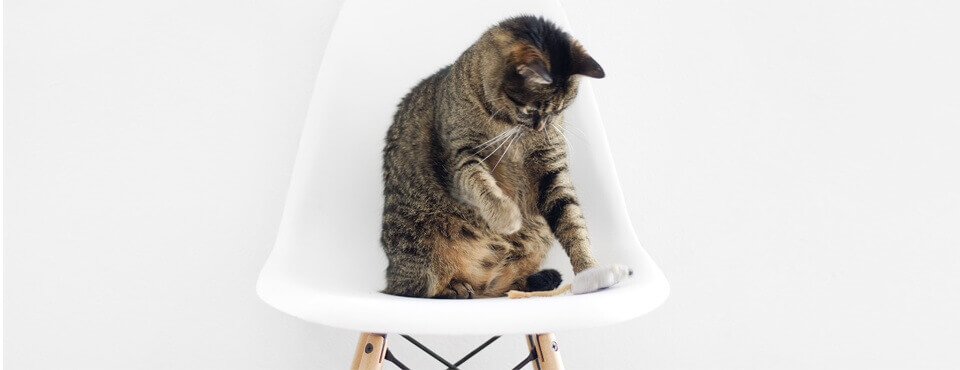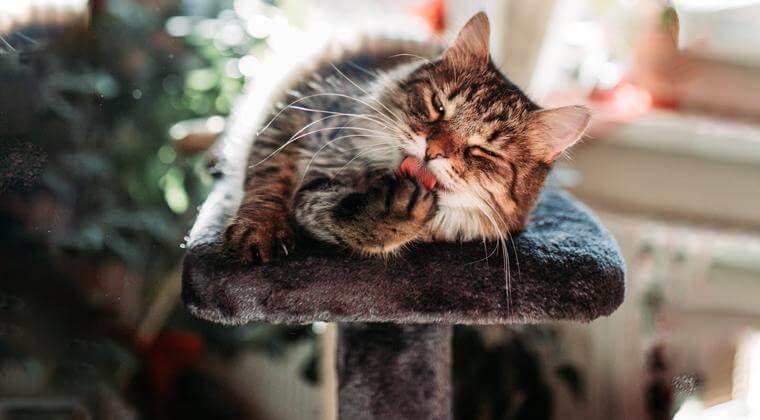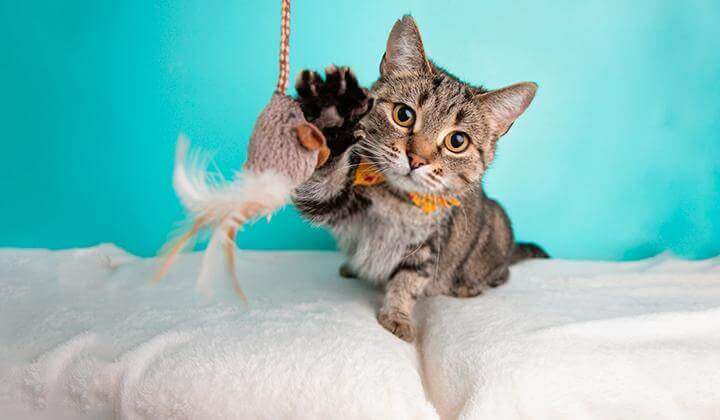5 Wild Cat Exercises To Help Indoor Cats Stay Fit
CATS
9 Apr, 2020
READ 7 minutes

If you find that your indoor cat really prefers lounging over lunging, you are not alone. Feline inactivity and obesity are problems around the world. Underactive and overfed cats, as well as those who beg for and receive table food, are at risk for gaining excess weight. Excess weight leads to a more sedentary life, and a more sedentary life leads to excess weight. It’s a vicious cycle that may lead to serious illnesses like diabetes. A healthy diet, along with indoor cat exercises, can help your cat stay fit throughout all stages of life.
HOW MUCH WEIGHT IS TOO MUCH WEIGHT?
The average medium cat weighs between 3 and 6 kilos (7 and 13 pounds). If you’re unsure of your cat’s weight, look at your cat’s body. Cats who maintain a healthy weight have a clearly defined waist if you look at them from above. If you look at your cat from the side, the area just behind the ribs should have a smaller diameter than the chest. This is called an abdominal tuck. If you are worried and cannot see your cat’s waist, consider discussing this with your veterinarian. Your veterinarian will be able to weigh your cat accurately and, if needed, recommend a healthy, weight-loss diet as well as some cat exercises to loose weight.

HOW MUCH ACTIVITY IS TOO LITTLE ACTIVITY?
One thing is for sure: cats are excellent sleepers. The average cat sleeps between 16 and 20 hours per day. Cats who live in the wild are no different. They sleep and eat just as much as your indoor cat. The difference is that when cats in the wild are awake, they are actively hunting prey—chasing and catching their next meal. Prowling for food helps them stay naturally fit. On the flip side, indoor cats have no need to hunt while they are awake, so staying active isn’t necessary for their survival, even though it is very beneficial for their health and wellbeing. If you’re wondering how to exercise your cat, it may be easier than you think. There are many cat exercises to choose from that your cat will love.
BRING THE WILD INSIDE
If you want to inspire your cat to get moving, offer toys that ignite his or her natural instinct to hunt. It’s easy to transform corners of your home into areas that will help your cat tap into his or her wild side. How to exercise your cat? Here are a few great ideas:
Create A Cave. When cats are out and about hunting, they are also out and about hiding in areas where they know they will be able to catch their prey. The first thing you can do is offer your cat a place to hide. You might think this is counter-intuitive to getting your cat to move, but it’s not. Cat caves, or tents as they are often called, create an environment where cats can feel safe and secure. Even though cats sleep for much of the day, much of their sleep is in a state that enables them to move quickly should the need arise. There are many different types of cat tents on the market, but you can also easily create your own using an old t-shirt and a piece of cardboard. Place your cat tent in an area of your home where you can offer your cat the next item on the list, toy prey. Your cat will be crouching in that tent, waiting to come out and pounce in a split second.
Offer Toy Prey. Cats like to hunt small things that move. A toy mouse or bug, especially one that’s motorized, will get your cat on the prowl in no time. The same is true for everything else mentioned, but you may need to find the toy version and tie a string to it so that you can move it around the room without your cat catching on that it’s you. Just be sure to allow your cat to catch the prey and play with it for a bit so that he or she can feel the thrill of a job well done. If you can’t stand the sight of a toy mouse or bug in your home, consider a beam of light. Laser beams can work wonders when you’re trying to get a cat moving. Cats chase the tiny ray of light anywhere in the room, it’s an easy way to get them moving. Cats also like to hunt birds. You can tie a few feathers on a stick and move the stick around the entrance to the cat cave. It won’t take long for you to see how active your cat can be when attempting to hunt. Be sure to place all feathery objects and strings out of reach when you are finished so that your cat doesn’t accidentally ingest anything that might be harmful.

Plant A Cat Tree. Okay, we’re not really talking about a real tree here, but we are talking about a tree that will inspire your cat to do one of the things that he or she does best: go vertical. Cats are natural climbers, and cat trees are one of the safest, surest ways to help your cat climb. If your cat is having trouble making it to the top, you can place a healthy treat or a fun toy at the top to inspire movement.
Create A Scratching Post. Scratching posts, like cat trees, offer cats a place to do something that they are instinctually wired to do: scratch. It may not seem like an important activity, but it is. Scratching posts offer an appropriate place for your cat to groom his or her nails. They also provide your cat a place to release stress, stretch their paws and legs, and release a scent that marks their territory. If you place a scratching post next to a cat tree, your cat will have the ability to climb and leap from object to object, without the said object being your couch! This is a great form of indoor cat exercise. You can purchase a scratching post at any pet store, but you can also easily make one on your own.
Have A Ball With Catnip. Catnip or catmint, Nepeta cataria, is a herb that many cats will go crazy for when they smell the scent of it in the air. You can place a bit of catnip inside a toy, preferably one that will keep them moving, like a catnip ball. It’s worth noting that catnip acts as a sedative when consumed by cats, so consumption isn’t really the goal here. It is safe for cats, and they do love it, but if you’re trying to make your cat more active, be sure to offer it in a way that will keep your cat wanting more of it. For more information on catnip – visit the page in this link.

If you’re trying to help your indoor cat stay fit, you really don’t need to invest a ton of time doing so. Short bursts of energy for ten minutes or less throughout the day will help your cat increase activity, build stamina and get an appropriate amount of exercise. When paired with a nutritionally-sound diet, your cat will be well on the way to staying healthy. Regular vet visits will help you monitor your cat’s weight and gain invaluable tips and feedback regarding the best diet for your feline friend so that you can enjoy each other’s company for years to come.







